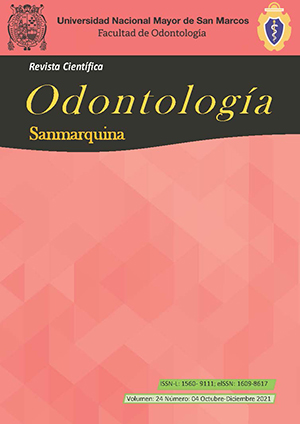Use of the Bichat fat ball flap for immediate closure of surgical defects in the palate. Report of two cases
DOI:
https://doi.org/10.15381/os.v24i4.19045Keywords:
Adipose tissue, Reconstructive surgery, Surgical flaps, Defects, Wound healing, (source: MeSH NLM)Abstract
The objective was to describe the use of the Bichat fat ball flap in the closure of palatal defects immediately after surgical resection. Clinical cases: clinical case number 1 (60-year-old man) presented to the consultation with an increase in volume of the soft palate mucosa, ovoid in shape, not painful on palpation, similar coloration of the palate mucosa, of 3 cm in diameter and 4 months of evolution that makes it uncomfortable to talk and feed. Clinical case number 2 (a 61-year-old man) attended the consultation with a lesion in the upper jaw at the level of the palate with a pathological diagnosis of pleomorphic adenoma. In both cases, tumor resection and immediate reconstruction were performed using a Bichat fat ball. The defects were covered only by the adipose tissue mentioned, generating a restitution ad integrum of the oral mucosa, they evolved favorably, without postoperative complications and recovering the masticatory function in a few weeks. The Bichat adipose ball flap should be considered an alternative for the repair of postsurgical defects thanks to its proximity, availability, plasticity and excellent vascularization, thus avoiding possible sequelae related to secondary healing.
Downloads
Downloads
Published
Issue
Section
License
Copyright (c) 2021 Ezequiel Matías Hilber, Matías García Blanco, Carlos Lazarte, Victoria Santucci, Sebastián Ariel Puia

This work is licensed under a Creative Commons Attribution 4.0 International License.
AUTHORS RETAIN THEIR RIGHTS:
a. Authors retain their trade mark rights and patent, and also on any process or procedure described in the article.
b. Authors retain their right to share, copy, distribute, perform and publicly communicate their article (eg, to place their article in an institutional repository or publish it in a book), with an acknowledgment of its initial publication in the Odontología Sanmarquina.
c. Authors retain theirs right to make a subsequent publication of their work, to use the article or any part thereof (eg a compilation of his papers, lecture notes, thesis, or a book), always indicating the source of publication (the originator of the work, journal, volume, number and date).




















